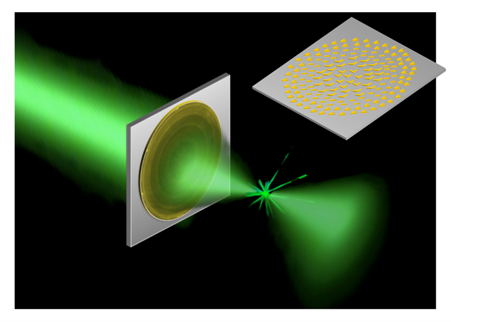An ultrathin, flat lens that offers a perfect image has been created by physicists belonging to the Harvard School of Engineering and Applied Sciences (SEAS). The lens focuses light without distortions.
 A new ultrathin, flat lens focuses light without imparting the optical distortions of conventional lenses. (Artist's rendition courtesy of Francesco Aieta.)
A new ultrathin, flat lens focuses light without imparting the optical distortions of conventional lenses. (Artist's rendition courtesy of Francesco Aieta.)
Conventional lenses impart distortions and optical aberrations including the “fish-eye” effect, astigmatism and coma aberrations. The new flat lens has a thickness of 60 nm and is made of an ultrathin wafer of silicon. This wafer is plated with a layer of gold with the thickness of an nm. Parts of the gold layer are stripped away and a V-shaped structure array is left behind. These structures are evenly spaced across the surface. When a laser is shone on the flat lens, the V-shaped structures function like nanoantennas. They capture the light coming in, hold on to it for a short period, and then release them again.
Modifying the size, spacing and angle of the antennas can help tune the array for specific wavelengths of light. The flat lens surfaces may possibly be used instead of bulky components in most optical systems.
The flat lens operates at wavelengths that are used in fiber-optic communications - telecom wavelengths. They are simple to produce and they can be scaled from near-infrared to terahertz wavelengths. The new technology depicts a novel method of producing a flat lens. An instantaneous phase shift is created at the lens surface. It does not require any creation of phase delays when light moves through the thickness of the material.
The results of the study have been published in Nano Letters.